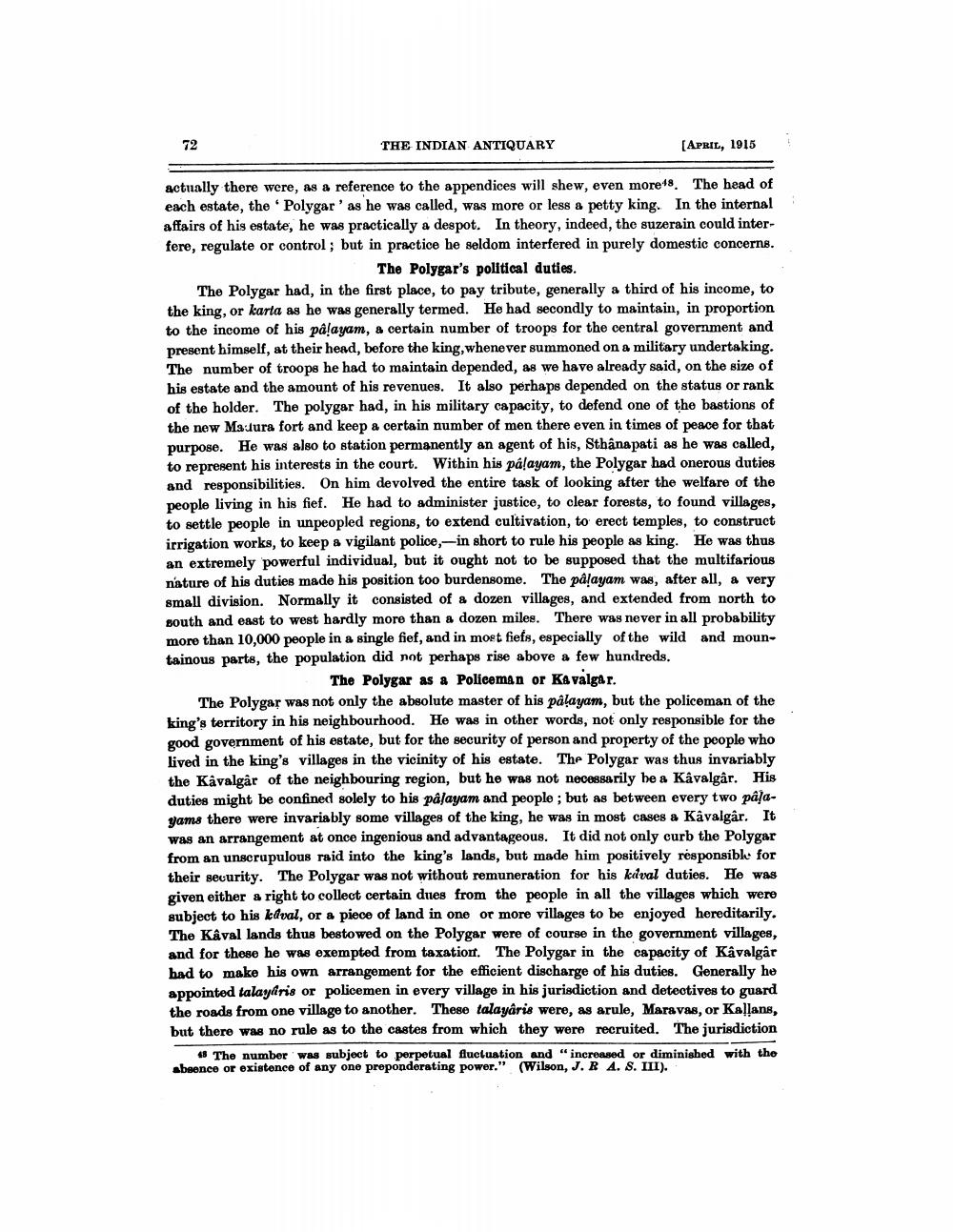________________
THE INDIAN ANTIQUARY
[APRIL, 1915
actually there were, as a reference to the appendices will shew, even more18. The head of each estate, the Polygar' as he was called, was more or less & petty king. In the internal affairs of his estate, he was practically a despot. In theory, indeed, the suzerain could interfere, regulate or control; but in practice he seldom interfered in purely domestic concerns.
The Polygar's political duties. The Polygar had, in the first place, to pay tribute, generally a third of his income, to the king, or karta as he was generally termed. He had secondly to maintain, in proportion to the income of his palayam, a certain number of troops for the central government and present himself, at their head, before the king, whenever summoned on a military undertaking. The number of troops he had to maintain depended, as we have already said, on the size of his estate and the amount of his revenues. It also perhaps depended on the status or rank of the holder. The polygar had, in his military capacity, to defend one of the bastions of the new Mautura fort and keep a certain number of men there even in times of peace for that purpose. He was also to station permanently an agent of his, Sthanapati as he was called, to represent his interests in the court. Within his palayam, the Polygar had onerous duties and responsibilities. On him devolved the entire task of looking after the welfare of the people living in his fief. He had to administer justice, to clear forests, to found villages, to settle people in unpeopled regions, to extend cultivation, to erect temples, to construct irrigation works, to keep a vigilant police,-in short to rule his people as king. He was thus an extremely powerful individual, but it ought not to be supposed that the multifarious nature of his duties made his position too burdensome. The palayam was, after all, a very small division. Normally it consisted of a dozen villages, and extended from north to Bouth and east to west hardly more than a dozen miles. There was never in all probability more than 10,000 people in a single fief, and in moet fiefs, especially of the wild and mountainous parts, the population did not perhaps rise above a few hundreds.
The Polygar as a Policeman or Ka valgar. The Polygar was not only the absolute master of his palayam, but the policeman of the king's territory in his neighbourhood. He was in other words, not only responsible for the good government of his estate, but for the security of person and property of the people who lived in the king's villages in the vicinity of his estate. The Polygar was thus invariably the Kávalgår of the neighbouring region, but he was not necessarily be a Kávalgår. His duties might be confined solely to his palayam and people ; but as between every two paļayams there were invariably some villages of the king, he was in most cases a Kávalgår. It was an arrangement at once ingenious and advantageous. It did not only curb the Polygar from an unscrupulous raid into the king's lands, but made him positively responsible for their security. The Polygar was not without remuneration for his kival duties. He was given either a right to collect certain dues from the people in all the villages which were subject to his kelval, or a piece of land in one or more villages to be enjoyed hereditarily. The Kával lands thus bestowed on the Polygar were of course in the government villages, and for these he was exempted from taxation. The Polygar in the capacity of Kavalgar had to make his own arrangement for the efficient discharge of his duties. Generally he appointed talayiris or policemen in every village in his jurisdiction and detectives to guard the roads from one village to another. These talayâris were, as arule, Maravas, or Kallans, but there was no rule as to the castes from which they were recruited. The jurisdiction
# The number was subject to perpetual fluctuation and "increased or diminished with the absence or existence of any one preponderating power." (Wilson, J. R 4. S. III).




